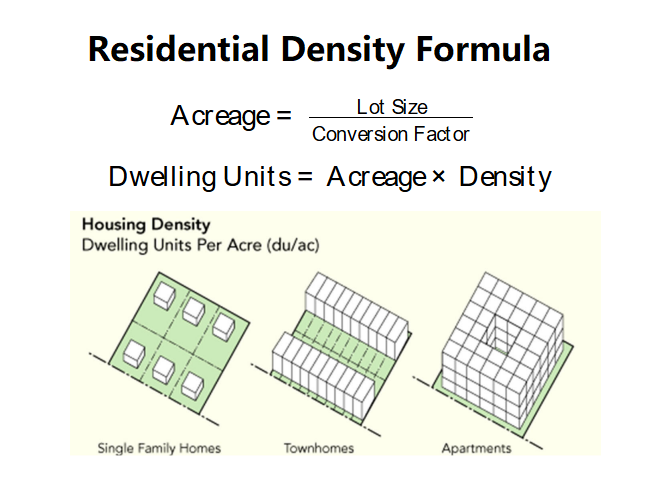1. What is Residential Density Calculator?
Definition: This calculator computes the acreage and the minimum and maximum number of dwellings permitted on a lot based on its size and density range.
Purpose: Assists urban planners, developers, and architects in determining residential capacity per zoning regulations.
2. How Does the Calculator Work?
The calculator uses the following steps:
Step 1: Calculate Acreage
\( \text{Acreage} = \frac{\text{Lot Size}}{\text{Conversion Factor}} \)
Where:
- \( \text{Lot Size} \): Lot size in square feet (sq. ft.) or square meters (sq. m.)
- \( \text{Conversion Factor} \): 43,560 sq. ft./acre or 4,046.86 sq. m./acre
Step 2: Calculate Dwelling Units
\( \text{Dwelling Units} = \text{Acreage} \times \text{Density} \)
Where:
- \( \text{Density} \): Units per acre (du/ac), minimum and maximum values
Results are rounded to the nearest integer.
Steps:
- Enter the lot size with unit (sq. ft. or sq. m.) and minimum/maximum density.
- Convert lot size to acreage and multiply by density ranges.
- Display with 2 decimal places for acreage and 0 for units.
3. Importance of Residential Density
Calculating residential density is crucial for:
- Urban Planning: Ensures compliance with zoning laws and infrastructure capacity.
- Development Feasibility: Determines the number of homes or apartments possible.
- Resource Allocation: Guides water, power, and road planning based on unit density.
4. Using the Calculator
Example 1: Lot Size = 20,000 sq. ft., Min Density = 24.1, Max Density = 60:
- Lot Size: 20,000 sq. ft.
- Acreage: \( \frac{20,000}{43,560} \approx 0.46 \) acres
- Minimum Units: \( 0.46 \times 24.1 \approx 11.1 \) → 11 units
- Maximum Units: \( 0.46 \times 60 \approx 27.6 \) → 28 units
- Result: Acreage = 0.46 acres, Min Units = 11, Max Units = 28
Example 2: Lot Size = 1,858 sq. m., Min Density = 15, Max Density = 30:
- Lot Size: 1,858 sq. m.
- Acreage: \( \frac{1,858}{4,046.86} \approx 0.46 \) acres
- Minimum Units: \( 0.46 \times 15 \approx 6.9 \) → 7 units
- Maximum Units: \( 0.46 \times 30 \approx 13.8 \) → 14 units
- Result: Acreage = 0.46 acres, Min Units = 7, Max Units = 14
5. Frequently Asked Questions (FAQ)
Q: What is a typical density range?
A: Varies by zoning; urban areas may allow 20-60 units/acre, suburban 5-20 units/acre.
Q: Why convert to acres?
A: Density regulations in many regions are defined per acre, requiring consistent units.
Q: Where to find lot size and density?
A: Check local zoning codes or property deeds for lot size and density regulations.
Residential Density Calculator© - All Rights Reserved 2025
 Home
Home
 Back
Back
